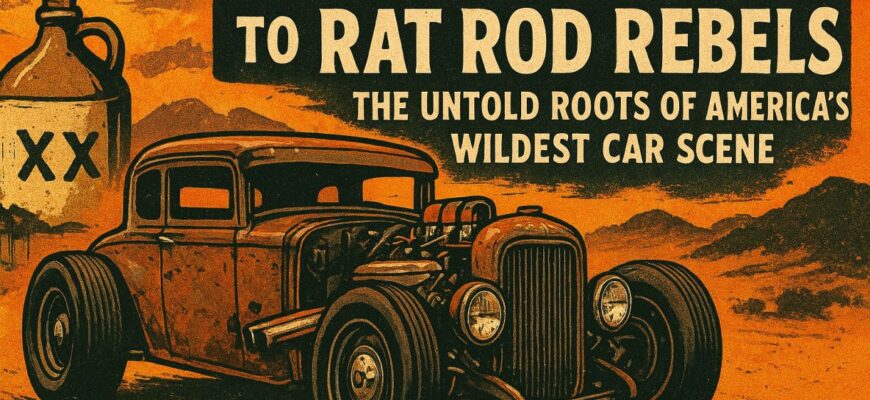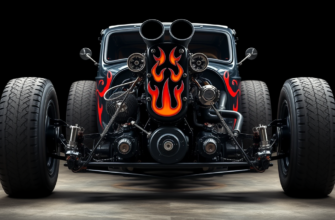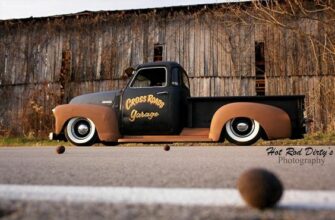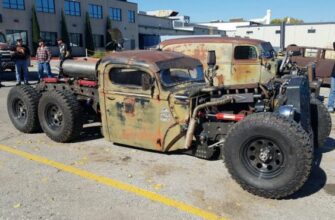The scent of scorched rubber, the raw thunder of an unmuffled V8, the glint of rust and primer under a setting sun—this is the visceral language of the rat rod. To the uninitiated, these machines appear as chaotic assemblages of automotive anarchy, a rebellion against the gleaming perfection of a concours d’elegance. But to dismiss them as mere junkyard art is to miss the profound point. The rat rod, in all its rough-hewn, defiant glory, is not a rejection of automotive history. It is, in fact, its purest, most authentic echo. It is the direct spiritual descendant of America’s first and most daring car culture, born not on sunny California boulevards, but in the dark, twisting hollows of the Appalachian Mountains, fueled by a different kind of spirit entirely: moonshine.
This is a story of necessity birthing innovation, of rebellion forging an identity, and of how the outlaw spirit of Depression-era bootleggers was passed down like a mechanical DNA, eventually exploding into a global phenomenon that celebrates imperfection, ingenuity, and raw, unadulterated soul. It is the untold root of America’s wildest car scene.
The Appalachian Crucible: Where Necessity Was the Mother of Invention
Long before the term “hot rod” entered the lexicon, a silent, high-stakes arms race was underway on the backroads of the American South. The era of Prohibition (1920-1933) had created a massive, illicit market for homemade alcohol, or moonshine. Producing the corn liquor was one thing; delivering it to thirsty customers while evading law enforcement was another, far more dangerous challenge. The government agents, or “Revenuers,” were a constant threat, and outrunning them required more than just local knowledge; it required a superior machine.
The moonshiners started with what they had, typically ordinary-looking Ford sedans and coupes. But under their mundane exteriors, a transformation began. This was not a hobby; it was a livelihood and a matter of freedom. Every modification had a purpose.
The focus was on power, handling, and load capacity. The flathead V8 engine, introduced by Ford in 1932, was a godsend. It was compact, relatively simple, and responded dramatically to modifications. Shunners would rip out any unnecessary weight—back seats, passenger seats, trim—to make room for more jars and to improve power-to-weight ratio. They would overhaul the engines, porting and polishing heads, milling blocks, and crafting custom intakes to squeeze out every possible horsepower. Suspensions were reinforced with stiffer leaf springs to handle the immense weight of hundreds of gallons of shine without bottoming out on rough dirt roads. Brakes were upgraded for better stopping power, and tires were chosen for durability and grip.
Perhaps the most ingenious adaptation was the creation of the “whiskey six-pack”—a system of three auxiliary fuel tanks filled not with gasoline, but with moonshine. In the event of a chase, the driver could flip a valve and dump his illicit cargo onto the road, lightening his load instantly and creating a slippery, dangerous hazard for pursuing lawmen.
These men were the original performance tuners. They worked in secret, sharing knowledge in whispers and through demonstration. Their genius was born of absolute necessity. They weren’t building cars for show; they were building tools for survival. This pragmatic, no-frills, performance-above-all-else philosophy is the foundational bedrock upon which all subsequent American performance car culture is built. The psychology was clear: function, in its most extreme form, is beauty.
From Outlaw to Icon: The NASCAR Connection and the Birth of the Hot Rod
When Prohibition ended, the skills and the fast cars didn’t just vanish. They found a new outlet. The men who had spent their nights outrunning Revenuers now found themselves with unparalleled driving skills and mechanically superior machines. A new question emerged: whose car was truly the fastest?
Informal races began on deserted stretches of road, a practice that quickly evolved into organized, if still illegal, competitions on dirt tracks carved out of local fields. These races were raw, dangerous, and immensely popular. The drivers were local heroes, their reputations forged on the moonshine trails.
This direct lineage is most famously embodied by individuals like Robert Glenn “Junior” Johnson. A legendary moonshine runner from Wilkes County, North Carolina, Johnson was famously captured by police at his family’s still (though he never served time for running). He parlayed his preternatural driving skills into a storied NASCAR career, winning 50 races as a driver and 139 as a car owner. He was living proof that the transition from illicit runner to celebrated racer was not just possible, but a natural progression.
This era marked the crucial shift. The moonshine runner’s car, a tool of subterfuge, became the stock car, a tool of competition. The ethos of modification for pure performance moved from the shadows into the spotlight of the oval track. Simultaneously, on the other side of the country, returning World War II GIs, trained as mechanics and pilots and hungry for speed and excitement, began applying the same principles to old Model Ts and Fords in California’s dry lake beds. The “hot rod” was officially born, and its genealogy traced directly back to the Appalachians.
The cultural DNA had been transferred. The hot rodder embraced the performance modifications but, in the land of sunshine and Hollywood, began to add a new layer: aesthetics. Chrome, custom paint, and sleek silhouettes became part of the language. Yet, the core remained: a powerful engine in a lightweight, modified vintage chassis. For a time, this was the dominant expression of car rebellion. But the seed of something even more primal was still dormant, waiting for its moment to return to its roots.
The Return to Roots: The Rise of the Rat Rod as a Philosophical Statement
By the 1980s and 1990s, the hot rod and custom car scene had become increasingly professionalized and expensive. Show cars were trailer queens, coated in glistening candy paints and buried under chrome, their value measured in tens of thousands of dollars. For many working-class enthusiasts, the soul of the movement seemed to have been lost. It had become a pursuit of perfection, a far cry from the gritty, improvisational spirit of its origins.
The rat rod was the inevitable backlash. It wasn’t a new idea; it was a homecoming.
Emerging from garage builders and backyard mechanics, the rat rod consciously rejected the high-dollar, glossy aesthetic. Its creators looked back not to the polished hot rods of the 1950s, but further back, to the functional, brutalist machines of the moonshiners. The term “rat rod” itself is believed to be a play on “hot rod,” implying something that is feral, unkempt, and unrefined.
The philosophy was deliberate and provocative:
- Authenticity over Pretense: Rat rods wear their history on their sleeve—literally. Patina, the weathered finish of aged steel and faded paint, is cherished, not stripped away. Bondo and perfect body lines are shunned in favor of honest rust and dents. It’s a celebration of the car’s life and story.
- Ingenuity over Budget: Rat rod builders are modern-day moonshiners in their resourcefulness. A grille from a ‘40s Chevy, a cab from a ‘30s Ford truck, a rear end from a ‘70s Cadillac, all brought together with handmade brackets and a welder’s artistry. The goal isn’t to impress with money spent, but with skill and creativity applied.
- Driving over Showing: A rat rod is meant to be driven hard. The rattles, the roar, the raw sensation of speed are features, not bugs. They are a direct connection to the experience of those early runners—a visceral, unfiltered communion between man and machine.
This movement was a profound psychological reclaiming of identity. It was a statement that the heart of car culture isn’t found in a bank account or a spray booth, but in the grease-stained hands of a builder and the courage of a driver. It connected a new generation of rebels directly to their untold heritage, creating a tangible, rolling monument to the original innovators who built their cars not for applause, but for freedom.
A Legacy Cast in Steel and Soul
The journey from the moonshine trails of Appalachia to the gritty showgrounds of a rat rod rally is more than a historical curiosity; it is a continuous narrative about the American relationship with the automobile. It is a story that argues that true innovation is often born from constraint, that authenticity has a beauty that perfection can never mimic, and that rebellion is a powerful, creative force.
The rat rod, in its defiant imperfection, stands as the most honest tribute possible to those first runners. It understands that the spirit of those men wasn’t about the moonshine itself; it was about the fierce independence, the mechanical genius, and the sheer audacity to modify one’s destiny with one’s own two hands. Every snarling, unpainted, home-built rat rod on the road today is a rolling testament to that spirit. It whispers a challenge to all of us: in a world increasingly polished, standardized, and digital, what raw, authentic, and beautifully imperfect thing have you built lately? The answer, perhaps, is waiting for you in the garage, not as a blueprint for a flawless showpiece, but as a collection of old parts and a desire to create something with a story, something with a soul.
| Section | Key Points |
|---|
| Era of Moonshine Runners | Bootleggers in the 1920s–30s modified cars for speed and stealth during Prohibition. |
| Birth of Hot Rodding | Post-WWII mechanics used surplus parts to build fast, stripped-down cars. |
| Rat Rod Philosophy | Emphasis on creativity, raw looks, patina, and function over polish. |
| Cultural Rebellion | Rat rods symbolize freedom, DIY ingenuity, and anti-establishment spirit. |
| Modern Scene | Builders mix history, art, and engineering — rat rods now appear at car shows, festivals, and on U.S. highways. |
(12)










